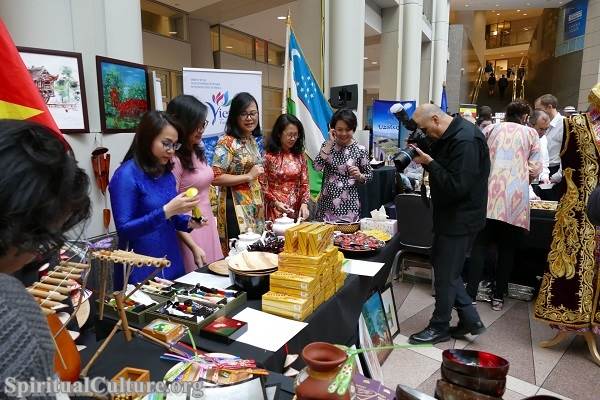The identity of the United States is a rich, complex tapestry woven from diverse immigrant histories, foundational democratic ideals, and deeply held spiritual beliefs. American holidays, therefore, are more than simply days off from work; they represent the essential cultural touchstones that unify this vast nation. They offer an annual rhythm for collective reflection, remembrance, and the reaffirmation of core societal values, ranging from national freedom to familial gratitude.
At Spiritual Culture, we believe the true measure of a holiday’s popularity lies not just in retail sales or public participation, but in its ability to evoke profound spiritual themes like justice, renewal, freedom, and love. Our ranking examines the holidays that have cemented their place in the American consciousness, leveraging both deep historical roots and contemporary relevance. It is an exploration of the deeper meaning and the collective heritage that makes these celebrations so vital to the American experience as of the Current Time of Writing.
Table of the Top 10 American Holidays by Spiritual and Cultural Significance
| Rank | Holiday | Core Significance/Theme | Cultural Participation (Estimate) | Spiritual/Historical Origin |
|---|---|---|---|---|
| 1 | Christmas | Giving, Family, Hope, Divine Incarnation | >85% (Cultural & Religious) | Christian/Pagan Winter Solstice |
| 2 | Thanksgiving | Gratitude, Harvest, Unity | >90% (Secular & Civic) | 1621 Pilgrim/Wampanoag Feast |
| 3 | Independence Day (Fourth of July) | National Freedom, Sacrifice, Self-Governance | >80% (Civic & Patriotic) | Declaration of Independence (1776) |
| 4 | Memorial Day | Remembrance, Selflessness, Sacrifice | High (Civic & Reflective) | Post-Civil War (Decoration Day) |
| 5 | Martin Luther King Jr. Day | Social Justice, Equality, Non-Violence | Growing (Civic & Ethical) | Civil Rights Movement |
| 6 | Easter | Renewal, Resurrection, Spring | >65% (Religious & Secular) | Christian/Ancient Spring Festivals |
| 7 | Halloween | Transformation, Boundary Crossing, Play | High (Secular & Folkloric) | Ancient Celtic Festival of Samhain |
| 8 | Juneteenth | Emancipation, Freedom, Black History | Rapidly Growing (Civic & Heritage) | Emancipation in Texas (1865) |
| 9 | New Year’s Day | Reset, Resolution, New Beginnings | High (Global & Secular) | Ancient Roman/Gregorian Calendar |
| 10 | Mother’s Day | Honor, Unconditional Love, Matriarchy | High (Personal & Familial) | Early 20th Century Civic Movement |
Top 10. Mother’s Day
Mother’s Day anchors our list as a profoundly personal holiday that elevates the spiritual principle of unconditional love and honor within the family unit. Established in the early 20th century, its founder, Anna Jarvis, originally envisioned it as a solemn day of reflection and prayer for mothers and their sacrifices, far removed from the commercial spectacle it has become. Despite its modern commercialization, the holiday remains one of the most widely recognized and personally observed in the nation, focused on recognizing the fundamental role of mothers in providing life and moral guidance.

The reason for its placement is its pervasive cultural impact built on a simple but powerful spiritual premise: honoring the source of life. For many, this observance is a deeply moving experience that involves expressing gratitude for the foundational, selfless love that sustains a family. It serves as an annual prompt for the American collective to pause and give thanks for the generative spiritual energy of the matriarch, reinforcing the idea that the strength of the nation begins in the home.
The holiday, as of the Current Time of Writing, is a necessary pause to reconnect with the virtues of selflessness and sacrifice inherent in motherhood. It is a vital cultural ritual that reminds us of the moral debt we owe to those who have raised us, ensuring that the spiritual principle of respect for one’s elders remains a celebrated core tenet of the American identity, even amidst the distractions of modern life.
Cultural/Spiritual Highlights:
- Core Virtue: Unconditional love and self-sacrifice.
- Original Intent: A day of prayer and personal reflection for mothers.
- Modern Impact: One of the most commercially significant holidays focused on personal gratitude.
- Spiritual Practice: The tradition of wearing a white or colored carnation to honor a deceased or living mother, respectively.
Top 9. New Year’s Day
New Year’s Day, celebrated globally, holds a specific American cultural significance as the ultimate day of collective renewal and personal spiritual reset. The tradition begins with the intense communal experience of New Year’s Eve, a time of reflective closure, before transitioning into the promise of January 1st. This holiday is fundamentally about the concept of tabula rasa—a clean slate—and the inherent human desire for self-improvement and transformation.

The spiritual impact of New Year’s Day is centered on the ritual of the New Year’s Resolution. This cultural practice, while often met with cynicism, is a profound expression of American individualism and the belief in the power of moral agency—the spiritual conviction that one can intentionally improve one’s character, health, and relationship with the Divine or the self. The holiday also provides a universal chronological marker for families and communities to mark the passage of time together.
As of the Current Time of Writing, this holiday is less about historical commemoration and more about future-oriented spirituality. It reminds the culture that life is cyclical, offering endless opportunities for a fresh start, a moral inventory, and a renewed commitment to personal goals. The shared hope and optimism following the midnight count down is a powerful, unifying spiritual energy for the nation.
Cultural/Spiritual Highlights:
- Core Virtue: Moral agency and the power of renewal.
- Key Ritual: The communal declaration of New Year’s Resolutions for self-improvement.
- Global Connection: Shared observance with global cultures, emphasizing universal human experience.
- Temporal Significance: Marks the ceremonial end of the Yuletide and Christmas season.
Top 8. Juneteenth
Juneteenth, officially Juneteenth National Independence Day (June 19th), is one of the most significant and rapidly growing cultural holidays, reflecting America’s ongoing spiritual reckoning with its own history. It commemorates the day in 1865 when enslaved people in Galveston, Texas, received the news of their freedom, two and a half years after the Emancipation Proclamation. This holiday fundamentally redefines the national understanding of freedom and liberation.
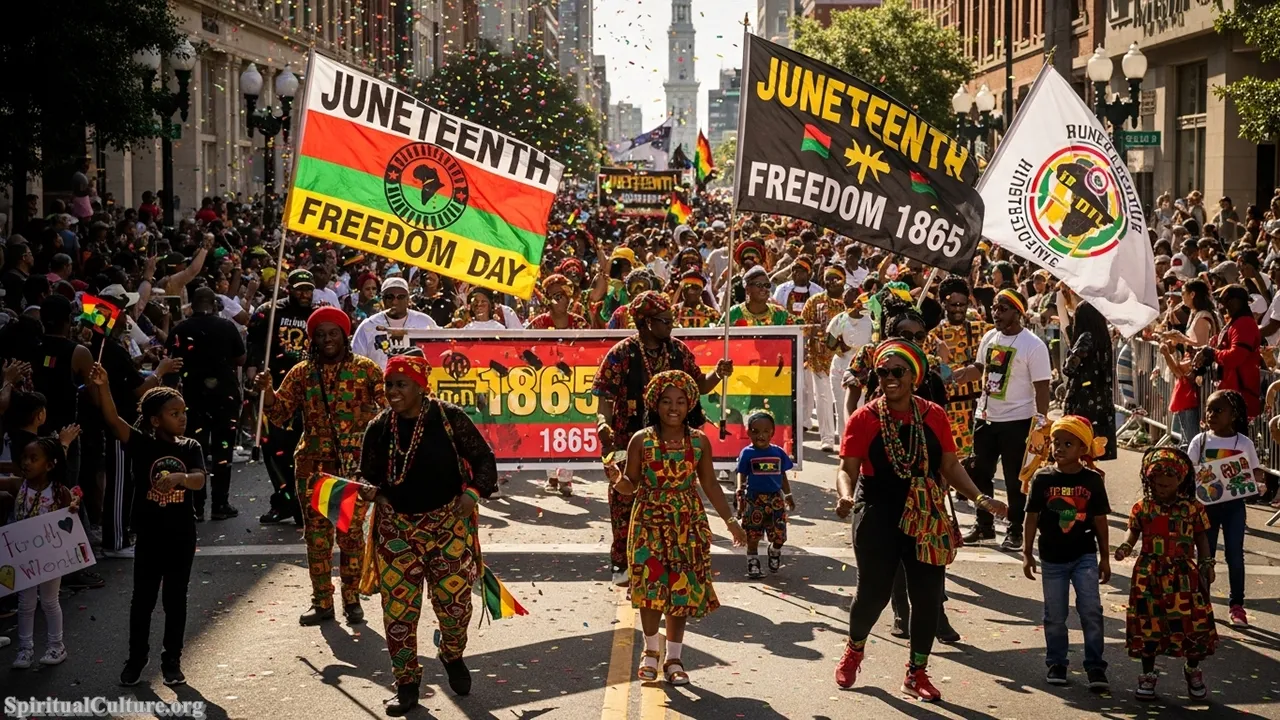
The holiday is ranked for its deep spiritual relevance, which transcends a mere historical date; it is a celebration of justice delayed but finally delivered, and a recognition of the endurance of the human spirit. Juneteenth offers a profound cultural moment to reflect on the moral stain of slavery, and to honor the resilience, faith, and heritage of African Americans. Its celebration, featuring parades, community gatherings, and educational events, transforms it into a national civic observance dedicated to the unfinished work of equality.
As a federal holiday since 2021, its adoption, as of the Current Time of Writing, symbolizes a major step toward a more complete national understanding of its own past. Juneteenth invites all Americans to engage in the spiritual practice of truth-telling and to commit to the ongoing pursuit of social justice, thereby strengthening the democratic and moral fabric of the country.
Cultural/Spiritual Highlights:
- Core Virtue: Freedom, delayed justice, and ancestral resilience.
- Historical Date: Commemorates the announcement of freedom in Galveston, TX, on June 19, 1865.
- Key Tradition: Red-colored food and drink (e.g., red velvet cake, strawberry soda) symbolizing the blood shed for freedom.
- Spiritual Practice: Educational outreach and a national recommitment to equality.
Top 7. Halloween
Halloween, or All Hallows’ Eve (October 31st), holds a high cultural rank due to its uniquely American blending of ancient spiritual traditions and modern secular spectacle. Originating from the Celtic festival of Samhain, where the veil between the worlds was believed to be thin, and later merging with Christian All Saints’ Day, it is a celebration centered on the themes of death, transformation, and the power of play.
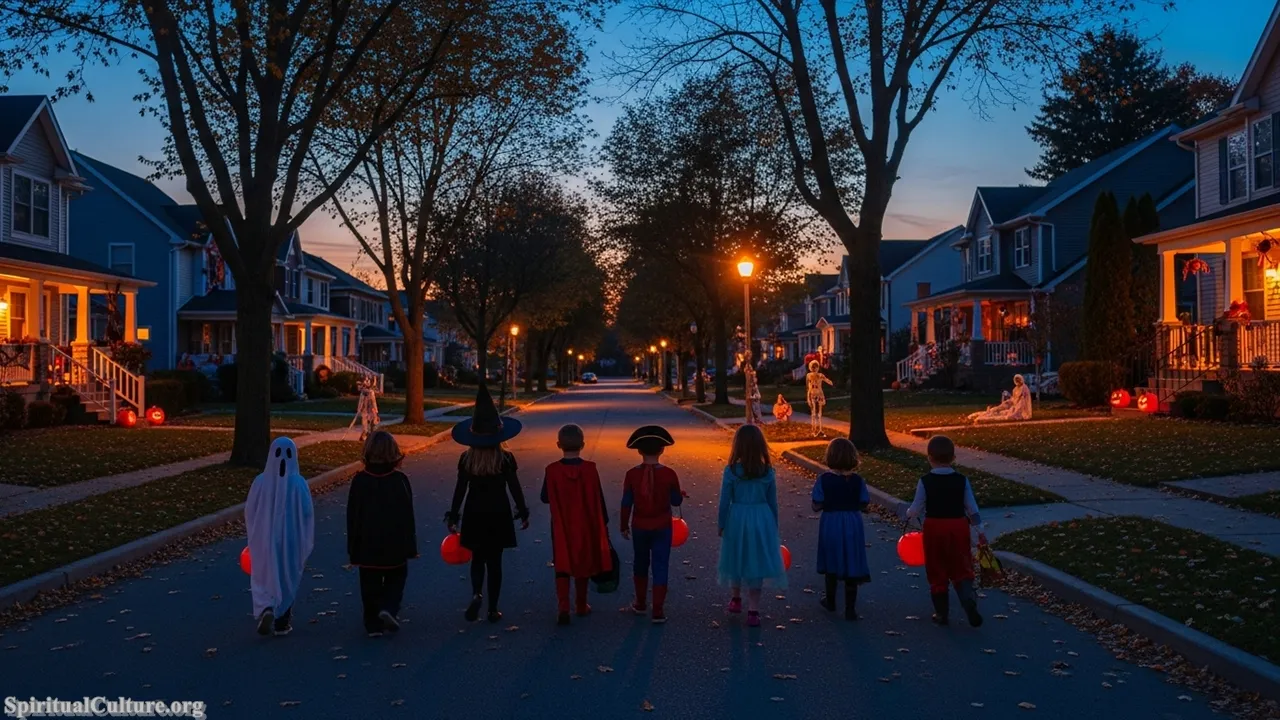
This holiday’s strength lies in its ability to offer a collective, ritualized confrontation with fear and the unknown. Through the practice of wearing costumes, Americans ritually transform themselves, blurring the lines of identity and embracing the archetype of the trickster and the mysterious. The act of “trick-or-treating” fosters a unique community dynamic, exchanging the fear of spirits (the trick) for generosity (the treat), a spiritual exchange rooted in folk magic and communal bonding.
As of the Current Time of Writing, Halloween has become a massive cultural and economic phenomenon, demonstrating the enduring human need to engage with the symbolic power of the dark and the cyclical nature of life and death, right before the solemnity of the end-of-year holidays begins. It is a powerful, anarchic spiritual release valve in the national calendar.
Cultural/Spiritual Highlights:
- Core Virtue: Ritualized confrontation with fear and the unknown.
- Origin: Ancient Celtic festival of Samhain (harvest and boundary crossing).
- Key Symbolism: The jack-o’-lantern (warding off malevolent spirits) and costuming (personal transformation).
- Cultural Ritual: Trick-or-treating, emphasizing a communal exchange of gifts.
Top 6. Easter
Easter is the highest-ranked Christian religious observance on this list, signifying resurrection, spiritual renewal, and the promise of eternal life for its Christian adherents. Falling in the spring, it seamlessly blends deep theological meaning with widespread secular traditions that speak to the universal human experience of renewal following the “death” of winter.

The reason for its high cultural ranking, beyond its religious importance, is its embodiment of the cultural theme of hope. The Resurrection narrative is central to the Christian faith, but the iconography of the holiday—the Easter Lily, the spring colors, the new clothing—aligns perfectly with ancient pagan celebrations of the Vernal Equinox and the rebirth of nature. This syncretism gives it cultural breadth, ensuring even secular families participate in the joyous, renewal-focused traditions of egg hunts and family meals.
As of the Current Time of Writing, Easter serves as a profound cultural moment for spiritual reflection on suffering, sacrifice, and ultimate redemption. It teaches the invaluable lesson that life persists beyond trial and that hope is perpetually renewed, a critical message that underpins much of the American ethos of perseverance.
Cultural/Spiritual Highlights:
- Core Virtue: Divine love, sacrifice, and the promise of resurrection/renewal.
- Seasonal Tie: Aligned with the Vernal Equinox, symbolizing the rebirth of nature.
- Key Symbols: The Easter Egg (life emerging from apparent death) and the Easter Lily (purity and hope).
- Spiritual Practice: The Lenten season of fasting and self-reflection leading up to the celebration.
Top 5. Martin Luther King Jr. Day
Martin Luther King Jr. Day (MLK Day) is a federal holiday dedicated to the spiritual principles of non-violence, justice, equality, and service. It is one of the few American holidays that honors an individual not for military achievement or political office, but for moral leadership and a commitment to prophetic social change.

This holiday is uniquely ranked for its focus on ethical spirituality and civic action. It is often designated as a national day of service, encouraging Americans to volunteer and engage in community upliftment. This shift transforms a day of historical remembrance into a living spiritual practice, challenging the nation to live up to the ideals of Dr. King’s dream. It is a powerful cultural call to introspection regarding systemic injustice and a renewed commitment to Dr. King’s vision of the “Beloved Community.”
As of the Current Time of Writing, MLK Day is a necessary annual corrective, reminding a diverse nation that the principles of justice and freedom, central to its founding documents, require continuous vigilance and sacrifice. It’s a spiritual anchor in the year, ensuring the culture remembers the moral high ground gained by non-violent resistance.
Cultural/Spiritual Highlights:
- Core Virtue: Non-violence, social justice, and moral courage.
- Key Observance: Designated as a National Day of Service (MLK Day of Service).
- Foundational Text: Dr. King’s “I Have a Dream” speech, a seminal spiritual and civic text.
- Spiritual Practice: Educational events promoting inter-racial dialogue and civic responsibility.
Top 4. Memorial Day
Memorial Day, observed on the last Monday in May, is a foundational American civic holiday centered on the sacred spiritual duty of remembrance and honor. Originally known as Decoration Day following the Civil War, its purpose is to honor the men and women who died while serving in the U.S. military. It marks the solemn bookend of the American collective narrative of freedom.
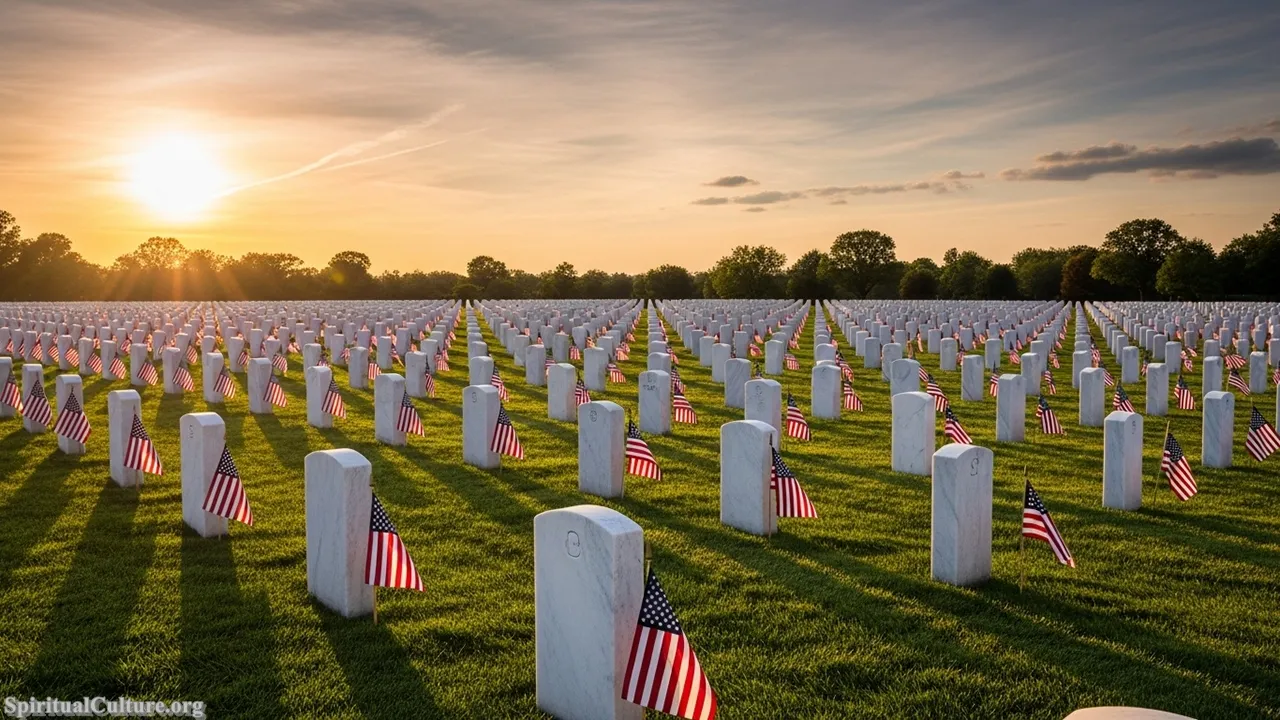
The spiritual impact of Memorial Day lies in its focus on selfless sacrifice. It is a day for the entire nation to pause and reflect on the enormous moral cost of freedom and the inherent value of service to a greater cause. The rituals—visiting cemeteries, placing flags, and the National Moment of Remembrance—are deeply spiritual acts of paying respects to ancestors and fallen heroes, connecting the living generation to the long line of those who gave their lives for the republic.
As of the Current Time of Writing, this holiday grounds the American spirit in humility and gratitude. It is a necessary counterbalance to the nation’s celebratory holidays, enforcing a period of contemplation that honors the transcendent value of citizenship and the solemnity of the ultimate sacrifice.
Cultural/Spiritual Highlights:
- Core Virtue: Remembrance, selfless sacrifice, and solemn honor.
- Key Ritual: Visiting cemeteries and placing flags on graves of the fallen.
- Symbolic Act: Observing the National Moment of Remembrance at 3:00 p.m. local time.
- Historical Root: Began as Decoration Day to honor Civil War dead.
Top 3. Independence Day (Fourth of July)
Independence Day is the nation’s premier civic and patriotic celebration, marking the spiritual birth of the American idea: the right to self-governance, liberty, and the pursuit of happiness. Commemorating the adoption of the Declaration of Independence in 1776, this holiday’s cultural significance is unparalleled in its unifying power.
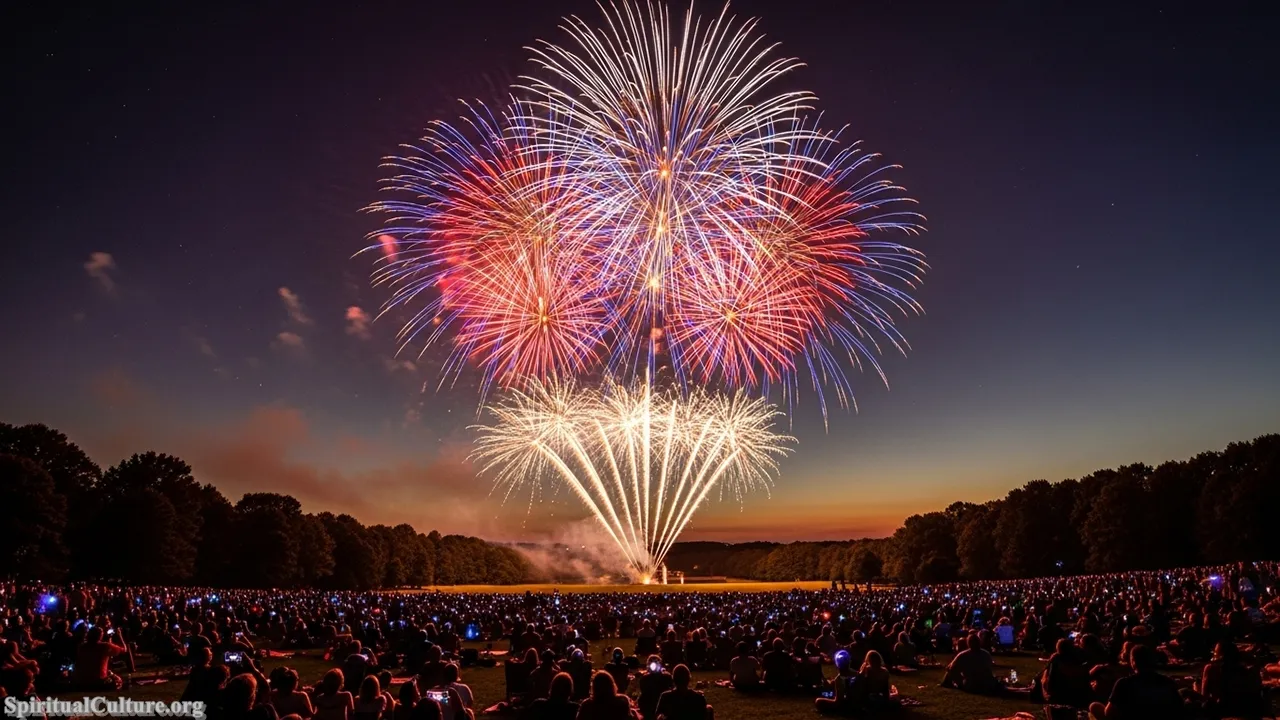
The deeper meaning of the Fourth of July lies in its affirmation of the American covenant—the shared belief in democratic ideals and the spiritual truth that all men are created equal. The iconic traditions of fireworks, parades, and public readings of the Declaration are powerful cultural rituals that reinforce this national identity. The act of celebrating national independence is, for many, a secular spiritual practice that renews their faith in the experiment of democracy.
As of the Current Time of Writing, Independence Day transcends mere partisanship; it is the annual moment when Americans collectively reflect on the blessings of freedom and the revolutionary spiritual audacity of the nation’s founders. It remains a necessary celebration of unity and the continued aspiration towards the ideals enshrined in the Declaration.
Cultural/Spiritual Highlights:
- Core Virtue: Liberty, democratic self-determination, and the pursuit of happiness.
- Key Ritual: Fireworks (symbolizing the “rockets’ red glare”) and civic parades.
- Foundational Text: The Declaration of Independence, viewed as a sacred civic document.
- Spiritual Impact: Collective renewal of national faith and civic responsibility.
Top 2. Thanksgiving
Thanksgiving Day is arguably the most unifying and profoundly spiritual secular holiday on the American calendar, centered entirely on the universal theme of gratitude, family, and shared harvest. Rooted in the 1621 harvest feast shared by the Pilgrims and the Wampanoag people, the modern holiday—proclaimed nationally by Abraham Lincoln—is a mandatory national pause for collective thankfulness.

The ranking is justified by its near-universal participation and its singular spiritual focus. Unlike other major holidays which can carry political, historical, or commercial baggage, Thanksgiving is primarily an inward, spiritual reflection on abundance and the blessings of the past year. The ritual of the family gathering, the shared feast, and the moment when attendees state what they are grateful for creates an annual spiritual anchor of humility and familial connection that transcends religious or regional boundaries.
As of the Current Time of Writing, Thanksgiving remains the undisputed cultural pinnacle of the harvest season, providing a critical reminder that true spiritual wealth is found not in accumulation, but in the simple act of acknowledging and sharing one’s blessings. It is a profound annual exercise in cultural humility and human fellowship.
Cultural/Spiritual Highlights:
- Core Virtue: Universal gratitude, humility, and family communion.
- Key Ritual: The shared, traditional family feast (turkey, stuffing, pie).
- Spiritual Practice: Expressing verbal thanks and counting one’s blessings at the table.
- Cultural Role: Marks the ceremonial start of the entire winter holiday season.
Top 1. Christmas
Christmas Day is the most popular and culturally dominant holiday in the American calendar, a powerful synthesis of religious sanctity and universal cultural themes, earning it the top spot. While its spiritual core is the Christian celebration of the birth of Jesus Christ, the holiday has become the undisputed centerpiece of the American year, encompassing themes of hope, divine incarnation, generosity, and familial reunion.

The deep spiritual impact of Christmas comes from its ability to inspire collective goodwill and a commitment to charity. The traditions of gift-giving, carol singing, and festive decoration are cultural rituals that echo the spiritual acts of the Magi’s offerings and the angelic proclamation of peace on earth. Even for those who do not adhere to its religious origins, the season embodies a powerful, shared belief in the possibility of joy, magic, and selfless giving, drawing the entire culture into its orbit.
As of the Current Time of Writing, Christmas serves as the ultimate spiritual and cultural magnet, slowing the entire nation for a period of reflection, reconnection, and generosity. It is a time when the American ethos of family, hope, and light triumphs over the cold and the dark, making it the most significant and spiritually resonant holiday.
Cultural/Spiritual Highlights:
- Core Virtue: Hope, divine love, and selfless generosity (gift-giving).
- Religious Significance: Commemorates the Incarnation of Christ.
- Key Symbolism: Light (candles, tree lights) triumphing over darkness (winter solstice).
- Cultural Tradition: The collective ritual of the Christmas Eve/Day family reunion.
Conclusion
The American cultural calendar, as detailed in this Spiritual Culture ranking, is much more than a collection of days off; it is a meticulously preserved spiritual rhythm for a diverse nation. From the profound gratitude of Thanksgiving to the joyous hope of Christmas, and the moral commitment of MLK Day, these holidays provide the essential narrative threads that bind a historically fractured and varied populace together. They serve as annual opportunities to transcend the daily routine and collectively engage with the great themes of human existence: life, death, justice, and renewal. By participating in these rituals, Americans are not merely observing tradition; they are actively reaffirming the civic and spiritual principles that underpin their society, ensuring that the deeper meaning behind the celebration remains vital for generations to come. The continued power of these holidays, as evidenced in the Current Time of Writing, demonstrates the enduring human need for shared ceremony and a collective pursuit of meaning.

